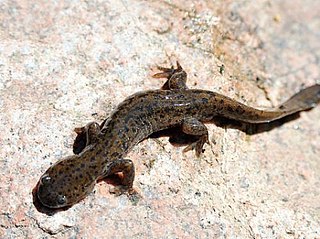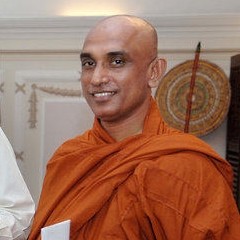
An environmentalist is a person who is concerned with and/or advocates for the protection of the environment. An environmentalist can be considered a supporter of the goals of the environmental movement, "a political and ethical movement that seeks to improve and protect the quality of the natural environment through changes to environmentally harmful human activities". An environmentalist is engaged in or believes in the philosophy of environmentalism or one of the related philosophies.

Korean Buddhism is distinguished from other forms of Buddhism by its attempt to resolve what its early practitioners saw as inconsistencies within the Mahayana Buddhist traditions that they received from foreign countries. To address this, they developed a new holistic approach to Buddhism that became a distinct form, an approach characteristic of virtually all major Korean thinkers. The resulting variation is called Tongbulgyo, a form that sought to harmonize previously arising disputes among scholars.

Sunderlal Bahuguna Ji was an Indian environmentalist and Chipko movement leader. The idea of the Chipko movement was suggested by his wife and him. He fought for the preservation of forests in the Himalayas, first as a member of the Chipko movement in the 1970s, and later spearheaded the anti-Tehri Dam movement from the 1980s to early 2004. He was one of the early environmentalists of India, and later he and others associated with the Chipko movement and started taking up wider environmental issues, such as being opposed to large dams.

A bhikkhu is an ordained male in Buddhist monasticism. Male and female monastics are members of the Sangha.

Force-feeding is the practice of feeding a human or animal against their will. The term gavage refers to supplying a substance by means of a small plastic feeding tube passed through the nose (nasogastric) or mouth (orogastric) into the stomach.

The Jogye Order, officially the Jogye Order of Korean Buddhism, is the representative order of traditional Korean Buddhism with roots that date back 1200 years to the Later Silla National Master Doui, who brought Seon and the practice taught by the Sixth Patriarch, Huineng, from China around 820 CE. The name of the Order, Jogye, was adopted from the name of the village where Patriarch Huineng's home temple, Nanhua Temple, is located,.

Narmada Bachao Andolan (NBA) is an Indian social movement spearheaded by native tribals (adivasis), farmers, environmentalists and human rights activists against a number of large dam projects across the Narmada River, which flows through the states of Gujarat, Madhya Pradesh and Maharashtra. Sardar Sarovar Dam in Gujarat is one of the biggest dams on the river and was one of the first focal points of the movement. It is part of the Narmada Dam Project, whose main aim is to provide irrigation and electricity to people of the above states.

The Korean salamander, or Gensan salamander, is the most common species of salamander on the Korean peninsula, and is also found and on Jeju Island and in the north-eastern Chinese provinces of Liaoning, Jilin and Heilongjiang. It typically lives on forested hills, and from time to time mass deaths occur in Korea when salamanders encounter man-made drainage structures. This has prompted Korean government officials to execute a series of mass evacuations in heavily salamandered areas.

Jogyesa is the chief temple of the Jogye Order of Korean Buddhism. The building dates back to the late 14th century and became the order's chief temple in 1936. It thus plays a leading role in the current state of Seon Buddhism in South Korea. The temple was first established in 1395, at the dawn of the Joseon Dynasty; the modern temple was founded in 1910 and initially called "Gakhwangsa". The name was changed to "Taegosa" during the period of Japanese rule, and then to the present name in 1954.
Martine Batchelor, a former Jogye Buddhist nun, is the author of several books on Buddhism currently residing in France. She and her husband, Stephen Batchelor, work mostly in the United Kingdom and occasionally in the United States. In addition to writing books, she leads meditation groups with her husband that incorporate aspects of Zen, vipassanā, and Tibetan Buddhism. Batchelor also blogs frequently for the U.S.-based Tricycle: The Buddhist Review. She studied Jogye Zen Buddhism for ten years at Songgwangsa with her former teacher Master Kusan Sunim, being ordained as a nun in 1975. Batchelor served as Kusan's interpreter on speaking tours of the United States and Europe from 1981 to 1985, the year she left monastic life, married Stephen Batchelor, and returned to Europe. There she became a member of Sharpham North Community and served as a guiding teacher at Gaia House, both of which are based in Devon, England. She has also led a Buddhist studies program at Sharpham College in Totnes, Devon. MB speaks English, Korean, and French and can read Chinese characters.

Venerable Athuraliye Rathana Thero, is a Sri Lankan [Sinhala Buddhist] Bhikkhu politician and a Member of Parliament. He is the only representative from Our Power of People's Party in the current parliament.

Nénang Monastery is a historical gompa for Buddhist monks and nuns belonging to Sera Monastery. It is located west of Lhasa in Doilungdêqên County in Tibet Autonomous Region.

Guru das Agrawal, also known as Sant Swami Sanand and Sant Swami Gyan Swaroop Sanand, was an Indian environmentalist, engineer, religious leader, monk, and professor. He was the Patron of Ganga Mahasabha, founded by Madan Mohan Malviya in 1905.

Venerable Bhikkhunī (Ayya) Tathālokā Mahātherī is an American-born Theravada Bhikkhunī, scholar and Buddhist teacher. She is also the co-founder of the Dhammadharini monastic community in California, which includes Dhammadharini Monastery, and Aranya Bodhi Hermitage. She was the recipient of the 2006 Outstanding Women in Buddhism Award, a presenting scholar at the 2007 International Congress on Buddhist Women's Role in the Sangha, and was appointed Preceptor for the historically-significant 2009 Bhikkhuni Ordination held in Perth, Australia.
Diane Wilson is an American environmental activist, an anti-war activist, and an author. In 1989, she was a shrimp boat captain in Calhoun County, Texas, and she saw an Associated Press article saying that the county had the most toxic waste disposal of all counties in America. Texas produces the most amount of chemical waste than any other state in the United States, with the majority of the pollution concentrated on the state's Gulf Coast. Wilson began a campaign against Formosa Plastics, a Taiwanese chemical company then building a PVC facility near her town, with tactics including several hunger strikes and sinking her own boat to draw attention to the matter. In 1994 she won "zero discharge" agreements from Formosa and Alcoa.

Seon or Sŏn Buddhism is the Korean name for Chan Buddhism, a branch of Mahāyāna Buddhism commonly known in English as Zen Buddhism. Seon is the Sino-Korean pronunciation of Chan an abbreviation of 禪那 (chánnà), which is a Chinese transliteration of the Sanskrit word of dhyāna ("meditation"). Seon Buddhism, represented chiefly by the Jogye and Taego orders, is the most common type of Buddhism found in Korea.

Daehaeng Kun Sunim was a Korean Buddhist nun and Seon (禪) master. She taught monks as well as nuns, and helped to increase the participation of young people in Korean Buddhism. She made laypeople a particular focus of her efforts, and broke out of traditional models of spiritual practice, teaching so that anyone could practice, regardless of monastic status or gender. She was also a major force for the advancement of Bhikkunis (nuns), heavily supporting traditional nuns’ colleges as well as the modern Bhikkuni Council of Korea. The temple she founded, Hanmaum Seon Center, grew to have 15 branches in Korea, with another 10 branches in other countries.

Cho Oh-hyun was a South Korean poet and Zen Buddhist monk.

Hanam Jungwon was a Korean Buddhist monk and Seon master. He was also the spiritual head(宗正) of what was to become the modern Jogye Order of Korean Buddhism. He was the Dharma disciple of Gyeongheo Seongu, and the Dharma brother of Woelmyeon Mangong.
















